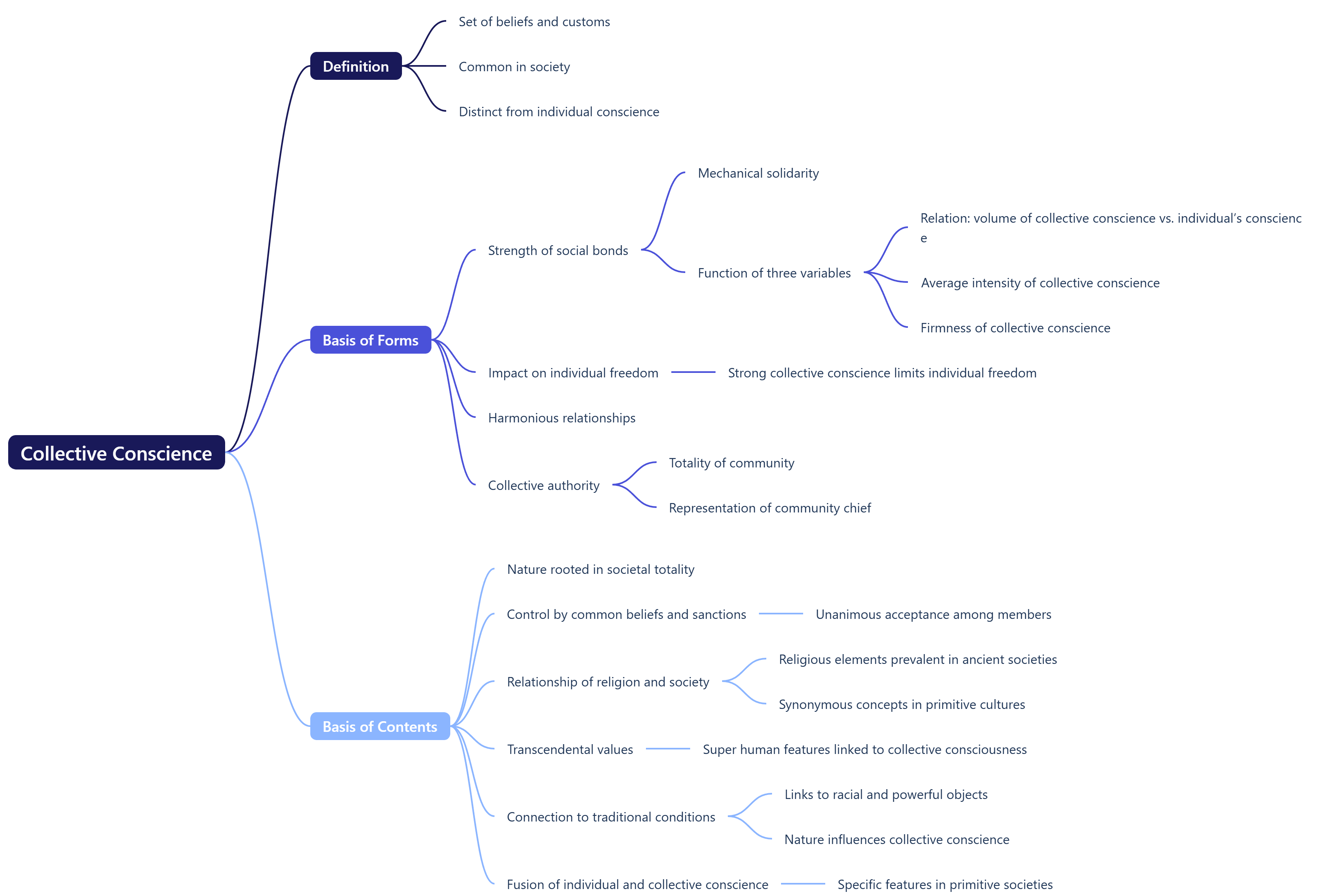Social Solidarity
(Relevant For Sociology Optional UPSC Paper I)

Mechanical SolidarityMechanical solidarity is sui generis i.e. born in the natural course of events based on resemblances of individuals. It directly links them with the society. This type of solidarity has arisen out of a number of common experiences of like members in a given society. Mechanical solidarity can be characterized by segmental system in which every segment is homogenous and involved in the social structure. Hence the society is divided into quite small compartments which envelop the individual completely. Originally, the segmental society was based on clans which were frequently found in less developed societies. But in the process of evolution, the segmental characteristics could not be confined to this one characteristic and started expanding on the bases of territories. Consequently, the division of the society was not solely according to the relation of consanguinity (real or fictitious) but also on territorial bases. The segmental social structure is characterized by a low degree of interdependence. What occurs in one segment hardly has any effects on others. Finally, it can be said that the segmental social structure has relatively low volume of moral and material density. This means that interactions take place among limited people (volume). It also means that the number of times people interact is also limited (density). The reason is that what one can do, the other can also do. So, he does not need others until more people are needed in a work. If a man has to cut a piece of wood, or catch a bird, or pick a fruit from a tree in a forest, he can do this work by himself like any other. Thus, people do the same type of work. They are similar; their inter-dependence is limited. Their density of interactions is low. Then a question arises what forms of custom regulate and control the conditions of people bound in mechanical solidarity? Durkheim answers this through collective conscience. Homogeneity of experience leads to the collective conscience. This gives rise to common beliefs and practices. The social life blended with religion and economic institutions of such a society, nearer to primitive communism as differentiations are few. Most of the property is common, the experiences are similar, and rules and regulations too relate to common life. Customs and laws protect the group — its property and its sentiments. The nature of laws is thus collective — a wrong-doer is punished by the collectivity. Penal or repressive law is an indicator of mechanical solidarity. Legal sanctions derived from the penal are directly proportional to the number of social bonds, which are regulated and controlled by collective conscience. Thus, we can understand the relative significance of the two. A wrong against the group is punished. On the one hand, punishment is given to the individual; on the other hand, punishment strengthens the beliefs and values of the society. Any wrong brings injury to the group sentiments; every punishment restores the authority of the collectivity. Collective Conscience
Now what is collective conscience under mechanical solidarity at the cultural and ideological level? Durkheim defines collective conscience as a set of beliefs and customs, which on an average are common in a society and form a determinate system, which has its own life-style. Collective conscience exists in a general form in society and one can easily differentiate between the characters relating to its form and those to its content. Collective Conscience: On the Basis of FormsDurkheim views that the strength of social bonds is the feature of mechanical solidarity and is a function of three variables. They are:
The more the beliefs and sanctions are present in the society, the less are the chances of freedom of an individual. Thus, where the mechanical solidarity is effective, there is strong and extensive collective conscience. It brings harmonious relationships in the activities of the people extensively. In such a social condition, it is difficult to distinguish individual’s conscience from the collective one. Hence, collective authority becomes the mode of totality, whether it involves the whole of the community or it incarnates the chief of the community. Collective Conscience: On the Basis of ContentsWith regard to the content of the collective conscience there are distinguishable elements; mainly, its nature is rooted in the totality of a society. It is so because society is controlled by common beliefs and sanctions, which are unanimously accepted by the members of that society. Indeed, in ancient era, the religious elements were spread in every aspect of the society and everything, which was social, was religious as well. Both words, religious and social, were synonymous in the primitive societies. The source of super human features was deeply rooted in the constitution of conscience. Collective and the social characteristics of the latter were deemed to be transcendental values. These societal conditions lifted people even beyond their own conscience. The stages of the collective conscience were concretely associated with traditional (local) conditions, linking individual to racial and powerful objects in the universe viz., animals, trees and many natural forces such as sun, moon, clouds etc. People have always been linking himself to such objects. These phenomena affect every conscience in the same way Thus, the fusion of the individual’s conscience with the collective indicates its form and object. Now it can be said that collective conscience acquires its specific features in different primitive societies. ORGANIC SOLIDARITYDurkheim viewed that division of labour is an essential condition of organic solidarity, and it gradually replaces that engendered by social likeness. Here individual depends upon those parts, which the society is composed of. In this respect a society is an arrangement of different and specific functions which are linked mutually by social bonds. In this conception the differences among the individuals are visible to the extent that everybody has his specific field of activities and confines himself or herself to that area only. Hence, the individual’s conscience is distinct from the collective conscience. New Forms of Collective Conscience in Organic SolidarityEven primitive societies are well organized in the society where organic solidarity is greater; the social structure is well organized and has the features opposite that of segmental social structure. Organized social structure is characterized by the system of different organs and each has a specific role. These organs are formed by different components, which are coordinated and subordinated to one another around a single central organ. This central organ influences the rest of the organism within reasonable limits. Organized social structure, in turn, gives rise to the fusion of the segments completely. Hence, an individual extends his sphere of interaction. As this process continues, it increases in its numerical strength and as such its impact is no longer restricted to the local place. The process of fusion of the segments leads to the fusion of markets, which crystallizes a single market (city). This virtually embraces whole society, which contains the entire population within its boundary. Thus, the society itself resembles a large city. Now, individuals are no longer grouped according to their lineage, but to their specified activities. The existing social conditions and the nature of work do not confine the individual to his birthplace, but also bring him out of it to the place of work. Organized social structure is thus characterized by high degree of interdependence. The increase in industrialization corresponds to the progress of division of labour and the latter determine the concentration of the social mass. Any change at one place is rapidly transmitted to the other. Therefore, the intervention of state/legal sanctions is needed. Finally, we can say that organized social structure has relatively high volume (material and moral density). With the above-mentioned advancements, societies become more and more voluminous and, in turn, work gets more divided. The population becomes even more concentrated with the advancement of the people as a whole. Whenever the social norms correspond to the organic solidarity, the division of labour gives rise to legal rules. These will determine the nature and relation of specialized functions and any violation is to be entailed through restitutive measures. Law, with sanctions of restitutive or cooperative nature, works as an index of organic solidarity; this index consists of civil, commercial, procedural, administrative and constitutional laws, which had been abstracted from the penal rules, found in the less-advanced societies. Here we find almost similar co-relation as was observed between penal law and mechanical solidarity. The extent of co-operative law is proportional to that part of social life, which consists in the bond, engendered by the division of labour. Here one can reasonably neglect those interdependent relations, which are regulated by the customs binding the individuals through similarity of work. Nevertheless, the legal and customary rules are essential for organic solidarity. For the existence of such a solidarity it is necessary that different parts cooperate in a determined way (if not in all respects, at least in predetermined conditions). Therefore, the contract is not self-sufficient, but it presupposes a set of regulations, which are as extensive and complicated as the contracted aspects. On the Basis of FormsNow we turn to the question of what form the collective conscience takes in the condition of organic solidarity. Having considered the volume of collective conscience, its intensity and determinateness, Durkheim argues about the forms of collective conscience where volume remains constant or probably diminishes, while its intensity and determinate character decline. Advancement of society through progressive development in the division of labour leads to a decline in the intensity and determinateness of collective states. The collective conscience seems to have less strength to carry the individuals in collective directions; as the rules of conduct to that of collective conscience become indeterminate, an individual gets more chances for self-reflection which, in turn, provides more opportunity for self-freedom. In other words, individual conscience no longer remains so tightly enmeshed in collective conscience, it acquires a certain degree of autonomy. On the Basis of ContentsThe content of collective conscience gradually becomes human oriented, secular and rational. These social conditions start weakening the values of collective curiosity from the society. The religious domain contracts in greater degree and the ever-strong domain of collective religious beliefs and sentiments starts decreasing with the rise of scientific procedures. The transcendental characters of society, which were superior to the human interests, begin losing their luster increasingly. Durkheim has seen the features of collective conscience in the system of beliefs. In advanced societies the supreme values not only bring dignity to an individual but also equality of opportunity. This has been explained in his work Ethic and social justice. |


